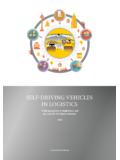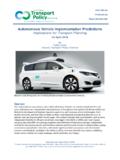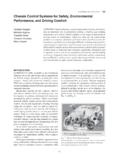Transcription of LiDAR: Driving the Future of Autonomous Navigation
1 LiDAR: Driving the Future of Autonomous Navigation A Frost & Sullivan Exclusive Whitepaper For Analysis of LiDAR technology for advanced safety 1. 2016 Frost & Sullivan LiDAR: Driving the Future of Autonomous Navigation Analysis of LiDAR technology for advanced safety LIDAR: Driving THE Future OF ADAS WITH Autonomous . INTELLIGENCE. Analysis of LiDAR technology for Advanced Safety Preface Safety and its improvement is a concern paramount to all passenger vehicle manufacturers. The value proposition for driver, passenger and pedestrian safety has become equally important as engine performance and fuel economy. This paper addresses how light detection and range (LiDAR) technology will impact Advanced Driver Assistance Systems and explore the term, Autonomous Driving intelligence.. The paper will consider Lidar technology today and how it stands to capture a large market share of automotive sensor technology in the Future .
2 Lidar is poised to penetrate the market in 2016 as the lead technology in automotive safety and Autonomous systems. Three primary approaches to Lidar development are considered, including Hybrid Solid-State Lidar, MEMS Lidar, and Mechanical Mechanism Lidar. Mechanical mechanism Lidar is the oldest and most traditional technology. MEMS Lidar technology is in the beginning stage of development as a low cost Lidar solution for low level automotive safety. Solid-state Hybrid Lidar (SH Lidar) was introduced in 2005 as a result of the Darpa Robotic Car Races. The technology has been tested for Autonomous safety over the years and the cost for SH Lidar dropped dramatically in 2015. With planned mass production to meet the growing demand for Autonomous Navigation and advanced safety, further dramatic cost reduction is expected in 2016 2017.
3 The development of Solid-State Hybrid Lidar (SH Lidar) was a break away from the traditional mechanical mechanism of single Lidar technology, and it is described in detail in this paper. The technology simplified what was previously a complex mechanical system of parts into one robust solid-state part. The solid-state developmental enabled faster data capture in 3D, capturing pictures instantaneously while moving in real-time at speeds of 30-40 MPH. SH Lidar technology has matured from an extremely costly technology and large system to being affordable, smaller in size, and headed toward mass production. SH Lidar technology is poised to be commercialized in 2015-16 and radically change the way we move about in the world. This paper looks at other sensor technology in use today in the automotive industry for safety. There are several type of sensors currently in use for ADAS (Advanced Driver Assistance Systems) levels 1 and 2 level, such as camera solutions, radar, and infrared sensors.
4 We will look at how sensor technology systems will potentially affect the Future of safety by improving what is currently offered and addressing safety levels of ADAS 3 and 4. 2. 2016 Frost & Sullivan LiDAR: Driving the Future of Autonomous Navigation Analysis of LiDAR technology for advanced safety The paper compares SH LiDAR, proposed MEMS technology, camera systems, and suites of sensors as the various systems apply to ADAS, Autonomous Driving , and Autonomous intelligence. Exhibit 01. Comparative Analysis of Various Automotive Technologies Short Range Long Range Radar Radar Ultrasonic Vision Infra Red LIDAR Implications for LiDAR. 24 GHz 77 GHz UWB. Very Good Short Range Barely Barely LiDAR enables short range Low Ideal solution Ideal solution Very Good (0 to 2m) satisfactory satisfactory detection resolution LiDAR enables high Very Good precision detection in real Nominal Very Good Low Barely Barely time with object detection Range Low Ideal solution Ideal solution resolution satisfactory satisfactory and recognition.
5 Radar (2 to 30m) resolution provides no object detection. Unique feature of ToF lasers Ideal solution Long Range Barely Needs Barely in LiDAR is most accurate Low Good Ideal solution (30 to 100m ) satisfactory improvement satisfactory real time long range resolution detection Except LiDAR & NDIR, all Narrow other sensors are limited Good Needs Vertical FOV Good Ideal solution Ideal solution Ideal solution to <10 degree range. LiDAR. Speed only improvement <10deg exhibits higher precision than NDIR. Multi-laser LiDAR. Wide Vertical Barely Barely eliminates flux & is the Very Good Good Very Good Ideal solution FOV >30deg satisfactory satisfactory only single sensor capable of narrow and wide range LiDAR is the only solution Angular Barely Needs able to maintain high image Very Good Good Very Good Ideal solution resolution satisfactory improvement resolution with utmost clarity.
6 Object speed LiDAR accurately measures Needs Needs measure- Ideal solution Ideal solution Very Good Ideal Solution speed of approaching improvement improvement ment objects in real time LiDAR is not impacted by Bad weather Barely Ideal solution Good Good Very Good Very Good environmental & ambient operation satisfactory light conditions Blockage Needs (impurity on Good Good Good Good Very Good improvement sensor). LIDAR rays are not Night Needs Good Good Good Ideal solution Ideal solution impacted by changes in operation improvement ambient light conditions LiDAR is not impacted by light/ sound interference Sensitivity to Barely satis- Barely Needs unlike Radar & Sonar. Lidar Good Good Ideal Solution Light factory satisfactory Improvement is immune to background noise & environmental changes unlik ultrasonic. Mass production &.
7 Barely Needs technology improvements Cost Very Good Very Good Ideal solution Good satisfactory improvement will drive price of LiDAR. down Source: Frost & Sullivan 3. 2016 Frost & Sullivan LiDAR: Driving the Future of Autonomous Navigation Analysis of LiDAR technology for advanced safety This paper will examine the roadmap and Future vision of Lidar sensor technology developers as the technology is poised to substantially increase vehicle safety across the industry. Lidar is the single best way of getting integral information about the world around you," said Douglas Thornton, an engineer at Battelle Memorial Institute, who works on automotive Lidar applications. - Nick Shchetko, Wall Street Journal, 2014. The difference between a 64-beam LiDAR, and a $150 single-beam unit, underscores an important point: not all LiDAR is created equal.
8 There are three primary levels of automotive applications one for mapping; another for limited driver-assistance functions; and the more forward-looking fully self- Driving vehicles.. - 11-Feb-2015 Automotive Engineering Magazine Source : 4. 2016 Frost & Sullivan LiDAR: Driving the Future of Autonomous Navigation Analysis of LiDAR technology for advanced safety CONTENTS. 1. Preface Analysis of LiDAR Technology for ADAS and Autonomous Intelligence 2. LiDAR Overview How LiDAR Works Solid-state Hybrid LiDAR and How it Works Optics in 3D Visualization Solid-State Hybrid LiDAR Summary A History of Real-Time LiDAR. 3. NHTSA and Automotive Safety Sensor Technologies for ADAS. Next Generation ADAS. NHTSA New Goals for Braking Automatic Emergency Braking (AEB). 4. Alternative Solutions to SH LiDAR for Autonomy Single Laser LiDAR. Camera and Radar MEMS, Flash LiDAR, and Phased Array (OPA) Technology for 3D Visualization Testing Durability and Reliability of SH LiDAR.
9 5. Testing Durability and Reliability of SH LiDAR. 6. LiDAR Form Factor and Placement on Vehicles 7. Roadmap to Autonomy 8. Mass Production of LiDAR and Cost Reduction Current SH LiDAR Production 9. Conclusion 5. 2016 Frost & Sullivan LiDAR: Driving the Future of Autonomous Navigation Analysis of LiDAR technology for advanced safety LIDAR OVERVIEW. How LiDAR Works LiDAR is a tool to measure the shape and contour of the ground and environment. It bounces a laser pulse off a target and then measures the time (and distance) each pulse traveled. The science is based on the physics of light and optics, measuring wavelengths in nanoseconds. In a LiDAR system, light is emitted from a rapidly firing laser. LiDAR gathers its information by sending out laser light and gathering the light each laser beam generates. Laser light travels and reflects off points of things in the environment like buildings and tree branches.
10 The reflected light energy then returns to the LiDAR sensor where it is recorded. Time of Flight or TOF is the way Lidar measures the environment and it is the most viable and proven technique used for detecting target objects. Simultaneously, as the lasers fire, firmware within a Lidar system is analyzing and measuring the data. The optical receiving lens within the LiDAR system acts like a telescope gathering fragments of light photons returning from the environment. Lasers generate and fire out billions of photons, but for each 1M. photons sent out, 1 photon returns. Lasers send out 1B photons to generate 1000 photons of returning information. The more laser beams used in a system, the more the information about the environment is gathered. Single laser Lidar systems and systems with 8 or fewer lasers are at a disadvantage because fewer photons are retrieved, thus less information compared to a multi-laser Lidar system equipped with 16 or more laser beams.







